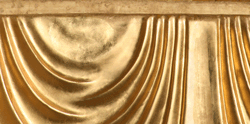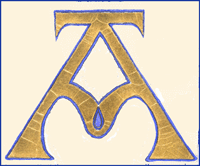Gold leafing (gilding) overview
Gold leafing – or, more properly, gold-leaf gilding – is the process of layering very thin sheets of gold (or imitation gold) onto a specially prepared hard surface such as metal or wood, or paper or vellum, to create a brilliant metallic effect.

A similarly shiny effect can also be achieved by layering on sheets of silver, copper or other metals. However, gold is most often used because:
- it is considered very attractive in just about every culture
- (real) gold can be burnished to a particularly brilliant mirror-like shine
- (real) gold is unreactive, so gilding doesn't deteriorate or oxidise like coatings of other metals
As well as using leaf, there are other ways of adding gold to artwork: real gold leaf paint (shell gold), and various other media. Read on for more about gold-leafing methods.
Why use gold-leafing in calligraphy?

Gold adds shimmer and resplendance to any object, and calligraphy decorated with gold harks back to those heady pre-Gutenberg days when the illuminated manuscript was the king of books. Whether you just add a simple touch to emphasise one word, or lavishly layer it all over the page for maximum dramatic impact, it's worth learning how to use gold leaf.
As mentioned above, the usual method is to cover the area to be gilded with a thin layer of some slightly sticky substance (called medium, size, mordant etc depending on who's writing) and then carefully lay very thin sheets of gold – 'leaves of gold' – over the top so they adhere. Presto. Solid gold effect!
Oil and water
There are two basic approaches: oil-based gold-leafing, and water-based gold-leafing. They're named respectively after the liquid used to make the size/medium/mordant.
Either one can be used for both flat work and for three-dimensional work.
Either may be of interest to the calligrapher!
Which method you use depends on:
- the surface you are working on
- the finish you require
- what other materials (such as paints) you want to use alongside your gold.
Gold-leafing using oil-based size

Oil-based gilding of three-dimensional areas is most often used for exterior work, such as architectural features like domes and spires, outdoor sculptures, the inner surfaces of carved letters on stone monuments, details on grand wrought-iron gates, etc.
(Note that for exterior work, only real gold leaf will do, and it should be as pure as possible. 24-carat pure gold is entirely non-reactive to most substances, and will not tarnish over time.)
Oil-based gilding of flat areas is sometimes used for gold writing in shop windows or on hanging signs for example. This may well be of interest to calligraphers.
The 'oil' used can be boiled linseed oil or a kind of gradually drying sticky varnish for the gold leaf to adhere to. This kind of oily sticky substance would soak into paper or animal skin and spoil the working surface if you tried to use it for a page of calligraphy. It would also interfere with water-based paints such as gouache or watercolour. Therefore, oil-gilding is NOT suitable for most calligraphic work on the page. However, for calligraphy on primed wood, glass, primed thick canvas, a signboard etc you would want to use oil-gilding.
Artists: Gustav Klimt used a lot of gold, presumably on an oil-based size. And I know for a fact that various kinds of metal leaf including gold can work with acrylic paints (though you will need to experiment to find your own best method).
Gold-leafing using water-based size

Water-based gilding of flat areas can be used for interior work on glass (if the size will stick) – but is more usually used to decorate pages of calligraphic text, or artworks on paper, vellum, canvas etc.
Flat water-based gilding is in fact the commonest, and easiest, method for calligraphers. There are all sorts of traditional and contemporary water-based sizes/mediums/mordants available. Basically, anything will work that remains slightly sticky when dry or that becomes slightly sticky when breathed upon.
Traditional water-based sizes for flat gold include:
- fish glue (the very fine quality stuff called isinglass does not smell as much as you would think)
- garlic juice (this by contrast smells just exactly as much as you would think)
- gelatin solutions (various recipes)
- glair (liquid drained of beaten egg-white; has to be diluted carefully so as not to crack when dry; various recipes, some adding sugar, honey etc)
- gum ammoniac solution (smells weird, like raw onions macerated in petroleum)
- gum arabic solution (various recipes, usually including sugar/honey; dilute carefully so it doesn't crack when dry)
- rabbit-skin glue (smells kind of soupy/boney when melted; noted it is not usually made of rabbits any more)
Contemporary water-based sizes for flat gold include:
- straight PVA glue (so, so convenient; dilute as needed; not sure how archival it is, though)
- commercial PVA-based sizes (often slightly coloured which is helpful)
- spray adhesive (good for large areas; mask carefully the areas not to be gilded; note, spray glue may not be of archival quality)
- there are others; I just haven't got to them yet ...
Water-based gilding of three-dimensional areas traditionally involves a slightly stickyish kind of plaster called gesso, or (often, these days) a gesso imitation.
So far as the calligrapher is concerned, water-gilding divides pretty much into two categories, only one of which is really interesting. I will leave you to guess which :-)
- Gold-leafing of interior objects (such as picture frames, interior architectural details etc). This traditional three-dimensional water-based gilding is commonly known just as 'water-gilding'. In its proper, traditional form, water-gilding is a longer and fiddlier process than oil-gilding, but it gives a superior, brighter finish.
- Gold-leafing of raised page decoration. The use of a gilded 'lump' of matter on a page makes the gold effect really stand out. This practice is ordinarily just called 'raised gilding' by calligraphers. It's an old technique which has hardly changed since the Middle Ages and can be seen as a special category of water-gilding, ie using slightly sticky water-based gesso.
Traditionally, gesso plaster to be used on a page was made super-fine so as not to show the slightest flaw, and this super-fine plaster goes by the particular name of gesso sottile (jess-oh sot-EEL-eh; Italian for 'fine plaster').
There are now many products available to calligraphers that are simpler to prepare and use than gesso sottile. That said, I would never discourage someone from learning how to water-gild 'properly'. It's a fine art in its own right, and much in demand especially for restoration and conservation: you might find it quite a profitable hobby!
Click for more on gold leaf application (loose and transfer).
Gold effects without using gold leaf
As mentioned above, there are other ways of getting a gold effect onto art and craft work, including 'real gold-leaf paint' and imitation gold-effect paints, gold-effect pastels, marker pens etc.
With the exception of the real gold paint, these are all cheaper methods which can be useful for roughing out artwork or for use in less important or low-cost pieces (such as a mass mailing of home-made Christmas cards.)
But gold leafing with its astonishing brilliance and historical resonance will probably always be the most impressive and glamorous technique, so it is well worth a little effort and investment for the pleasure it will bring you and others.
As a self-taught calligrapher I struggled with gilding to begin with, but now use it regularly. It's more than just a colour; gold elevates the status of a piece and gladdens the heart of the viewer. During the Middle Ages and Renaissance, gold was considered beneficial to the health. It is certainly very cheering. Generally, recipients and purchasers like seeing gold on calligraphic work, and they especially enjoy being told it's REAL gold :-)
And real gold-leaf doesn't have to cost much! In the UK, you can buy real gold leaf in books of just 5 sheets; in the US, Amazon.com do edible gold leaf (very pure 23-carat gold) cheaper than art gold leaf. If and when you want to buy gold leaf supplies, whether by mail-order or directly online, it is always worth comparing several price-lists; you can save a lot by shopping around.
Gold leaf application (loose and transfer gold leaf)
Gold leaf supplies -- online deals
Return from 'Gold Leafing' to the Calligraphy Skills homepage